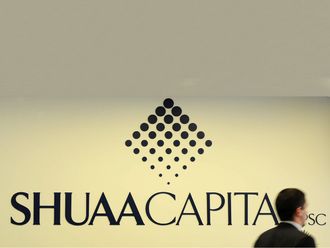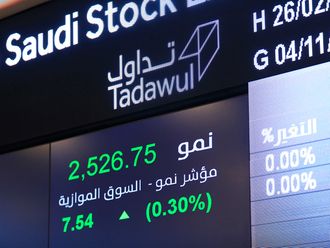Tokyo: Shares in Tokyo climbed into a bull market, as a sustained pullback in the yen against the dollar helped investors regain confidence in equity returns for export-reliant Japan.
The Nikkei 225 Stock Average advanced on Friday, bringing its gain from a June 24 low to 20 per cent and meeting the common definition of a bull market. The broader Topix rose for a seventh day to mark its longest such streak since August 2015. The gauge is still more than five points away from reaching the 20 per cent threshold. The yen lost 0.5 per cent against the greenback, extending its decline against the dollar to 5.3 per cent for this month, its steepest such slide in two years.
Tokyo equities are recovering after a turbulent start to the year that sent the Nikkei 225 down 21 per cent by June 24, buffeted by everything from a surging yen to the tumbling price of oil and the Bank of Japan’s move to introduce negative interest rates. The Japanese currency switched course since August, retreating from a near three-year high against the dollar on a global return of risk appetite, coupled with expectations for higher US interest rates.
“Most of it is linked to what’s happening with the yen versus the US dollar and expectations for Fed rate hikes continue,” said Andrew Sullivan, managing director for sales trading at Haitong International Securities Group in Hong Kong. “It does make the market a lot more attractive than when the yen was around 100. The real question is how long it will last.”
Broad Advance
More than 200 companies in the Nikkei 225 have posted gains since the June low, with silicon-wafer maker Sumco Corp., computer-manufacturer Fujitsu Ltd. and mobile game-company DeNa Co. leading the advance. By industry group, the rally has been driven by insurers, brokerages and lenders, with metals companies and energy explorers also surging.
Volatility in Tokyo has calmed after spiking earlier in the year after the BOJ moved to negative interest rates and when the UK voted to leave the European Union. While it jumped briefly this month after Donald Trump’s shock victory in the US election, that’s turned out to be a positive for Japanese equities so far, as Trump’s promises of fiscal stimulus boost inflation expectations and increase the odds of a Federal Reserve interest-rate increase this year, weakening the yen and benefiting Japan’s giant exporters.
The turnaround this year has been extreme. Up until the Nikkei 225’s low, Japanese equities were the second-worst performers among 94 primary indexes tracked by Bloomberg. Since then, the Nikkei 225 ranks fifth of the 94, with only shares in the Ukraine, Kazakhstan, Egypt and Venezuela posting larger gains. Since Trump’s election, Japanese shares are the third-best performer in the world.
Yellen Boost
Fed Chair Janet Yellen gave the dollar a further boost on Thursday as she told Congress a rate increase “could well become appropriate relatively soon.” She said she intends to remain until her term ends in January 2018. Traders put the chances of a Fed rate increase next month at 96 per cent, compared with 68 per cent at the beginning of this month.
Car manufacturers provided the biggest boost to the Topix on Friday, extending their recent rally. Auto shares have risen 29 per cent from their low in July, after tumbling earlier this year. The world’s largest carmaker, Toyota Motor Corp., jumped 2.7 per cent on Friday, while and Mazda Motor Corp. added 3.8 per cent. Electrical-appliance and component makers also rose, with Apple Inc. supplier Murata Manufacturing Co. advancing 4.3 per cent.
Abe, Trump
Japanese Prime Minister Shinzo Abe said Trump was a trustworthy leader in comments after his first meeting with the US president-elect, whose statements on trade and security have sparked concern in Japan. Abe told reporters in New York he had frank discussions in a “warm atmosphere” at the meeting.
Financial stocks have also underpinned the recovery. A measure of lenders traded on the benchmark gauge has clawed back more than half of its 41 per cent loss to this year’s low on July 8, extending gains recently after a global surge in borrowing costs after Trump’s US presidential win.
“Expectations for infrastructure investment led to a rise in US interest rates, and the dollar, moulding a pattern of yen weakness and share gains,” said Takashi Kamiya, chief economist for T&D Asset Management Co. in Tokyo. “As long as such expectations aren’t proven to be false, this pattern will continue. But given the U.S.’s budget deficit, we don’t know whether the infrastructure investment will materialise or not.”
The Nikkei 225 trades at 18 times estimated earnings, compared with 18.4 for the S&P 500 Index. As the Japanese gauge closed at 17,967.41 on Friday after spending part of the day above 18,000, Nomura Holdings Inc. chief technical analyst Shoko Tani says she’s expecting further gains, after the gauge broke above the upper limit of an indicator known as an Ichimoku cloud. Despite entering a bull market, the Nikkei is still down 5.6 per cent for the year.
“The next milestone I’m looking at is the psychologically important level of 20,000 and the December 2015 high of 20,012,” she said.












